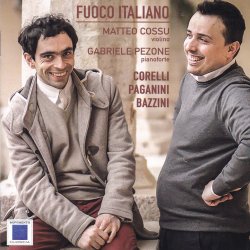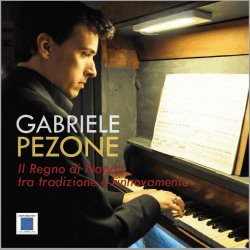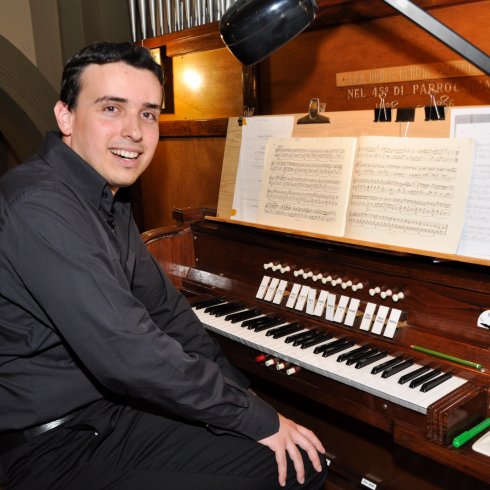

Fuoco italiano
Fuoco Italiano
From the dawn lo its extreme peak. Fuoco Italiano investigates the evolution of violin art with a decisive perspective cut. linked to the figure of the composer-interpreter. Not a temporal but thematic excursus: all the selected artists participate in romantic or late Romantic aesthetics as well as composers and performers of their own compositions. virtuosi of the instrument. There is also a reference lo the beginning of ltalian instrumental music with La Follia by Arcangelo Corelli (1653-1713) La Follia is not performed in its original form but in the late-Romantic transcription by Hubert Leo nard which amplifies the violin virtuosity lo bring the piece closer to the taste of its era. thanks to the introduction of a cadenza before the final va riation. Between Corelli and Leonard there was a series of virtuoso violinists who made the ltalian school glorious. allowing it to have influence throughout Europe but above all there was Niccolò Paganini (1782-1840). Creator of the modern figure of the performer and virtuoso performer. Paganini has composed primarily for himself entrusting the choice of the moment between the different executive possibilities of musical writing. La Campanella closes the Finale of Concerto No. 2 in B minor for violin and orchestra. composed by Paganini in 1826 for his glorious European tours. The tille of the final movement. which went on to indicate the entire concert. is due to the inclusion. in the orchestra of a bell thai plays the F-sharp and duets with the harmonics of the soloist. The virtuosity in writing the violin pari touches levels never seen with the introduction of different te chnical elements among which stand out the ar duous 'pinched with the left hand' and the double harmonics. The Cantabile in D major has a strongly different character than the Campanella, the pyrotechnic virtuosity is not necessary. therefore it is abandoned lor a cradling and dreamy style. Encouraged by Paganini. Antonio Bazzini (1818-1897) became one of the most brilliant violinists of the nineteenth century. There are many paraphrases and variations that Bazzini himself makes of "favorite arias" taken from the most significant and well-known works in the mid-ni neteenth century. The Fantasy on the Traviata Op. 50 summarizes the cardinal themes of the Ver di opera, the orchestral Prelude of Act I and lii. Amami Alfredo. Alfredo. Alfredo di questo cor and the Addio del passato with which Violetta painfully takes leave from life. The violin behaves like the first actor of a lyrical representation while the piano accompanies it warm sounds. brilliant episodes and an elegant virtuosity able to exalt those so famous melodies keeping them always fully recognizable. In the case of La ronde des lutin Op. 25. on the other hand. virtuosity is exasperated to the extreme with bow strokes borrowed from Paganini - like technique such as the ricochet which consists in making the bow jump on the string producing one or more notes obtaining a great brilliance effect. This fantastic joke presupposes an impeccable technique by the violinist and a mastery of the instrument really out of the ordinary and thai is why it is very rarely performed.



MATTEO COSSU
Started studying violin at a very young age, graduating from the Conservatorio “Morlacchi” in Perugia under the guidance of Ge org Mönch. He continued his education at the Ac cademia di Santa Cecilia in Rome, obtaining the high-level diploma in violin with Sonig Tchake rian and in chamber music with Rocco Filippini; he also perfected his studies with Carlo Maria Parazzoli, Pier Narciso Masi, Pierre Amoyal, Giu liano Carmignola and the Trieste Trio. As a soloist and in violin and piano duo he performed at the Chigi Saracini Hall in Siena, the Revoltella Museum in Trieste, the Kleines Studio in Salzburg, the Église des Gésuites in Sion, the Waikato Museum in Hamilton (New Zealand), for the Ita lian Cultural Institutes of Vienna, Sydney, Hong Kong. With the Orquestra Sinfónica del Estado de México he played the Concerto for Violin and Or chestra n. 2 by Béla Bartók directed by the Master Enrique Bátiz Campbell and with the Vratza State Philharmonic the Concerto in D major op. 61 of Beethoven directed by Gabriele Pezone. He regularly collaborates with the Concerto Barocco Chamber Orchestra of Rome, with whom he performs Vivaldi’s Four Seasons as a soloist. Parallel to his activity as a musician he obtained a three-year degree in Art, Music and Entertain ment and a master’s degree in Modern Philology. He holds a PhD in musicology at the University of Pavia, regularly publishes essays and articles in specialized magazines such as Studi Musicali. He currently collaborates with the Tartini Study Center for the publication of Giuseppe Tartini’s Opera Omnia.

Gabriele Pezone
He studied piano with Antonio Luciani, graduating at the Conservatory of Latina with Salvatore Coggi and choral music and choral conducting with Mauro Bacherini . He studied organ and organ composition with Luigi Sacco and composition with Alberto Meoli , organ improvisation with Stefano Rattni and he perfected in organ with Mariella Mochi and Olivier Latry and in piano with Alessandra Ammara and Roberto Prosseda. He studied liturgical animation with Marco Frisina and conducting with Nicola Samale and Deian Pavlov . He has conducted orchestras all around the world, including : Vidin State Philharmonic Orchestra (Bulgaria), Orquesta Sinfonica del Estado del Mexico, l'Orquesta Sinfonica de Yucatan, la Camerata de Coahuila, l'Orquesta de la Universidad Autonoma de Nuevo Leon, the Orquesta Sinfonica de la Universidad Autonoma del' Estado de Hidalgo and the Orquesta Sinfonica de Michoacan (Mexico), Lomza Chamber Phllharmon, Kallsz Orchestra and Philharmonic Orchestra (Poland), Orkestra Akademik Baskent (Turkey), the Southern Arizona Symphony Orchestra and the Las Colinas Symphony Orchestra (USA), the Cantell1d1milano Orchestra and the Sanremo Symphony Orchestra (Italy), the Orquesta Sinfonica de Loja (Ecuador), the Orchestra of the Opera of Ukraine, the Cairo Symphony Orchestra (Egypt), the West Bohemian Symphony Orchestra and the North Czech Philharmonic Orchestra (Czech Republic) in the prestigious Smetana Hall in Prague and the Bitola Chamber Orchestra (Macedonia). He has directed numerous operas, including "La Traviata” at the theatre "A. Manzoni" of Cassino, "Madama Butterfly" at the theater "G. D'Annunzio" of Latina and "Tosca " at the Borgiane Evenings of Nepi. He has also performed as a pianist or organist in Croatia, France, Sweden, Australia, Denmark, Spain, Hong Kong and New Zealand.
He is the founder of the Chamber Orchestra "Città Di Fondi". In 2006 he was the winner of the International Award "Giuseppe Sciacca", delivered to the Chamber of Deputies. He is the artistic director of the Fondi Music Festival , of the Festival Organistico Pontino and of the "lnFondi Musica" musical specialization courses. His performances were broadcast by TVP (Poland), Radio Mana, SAT2000, Rai Uno and Rai Tre. He recorded for Amadeus. As an accordionist he won the "Best Music Award" at the 8th Nicosia lnternational Folk Dance Festival (Cyprus)
